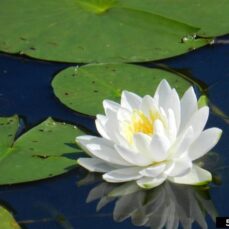Fragrant Water Lily (Nymphaea odorata subsp. odorata)

Photo credit: Brett Marshall, Sault College, Bugwood.org
Management Strategy
Squamish
Whistler
Pemberton
Vectors of Spread
ID Characteristics
Flowers: White, large (6 – 19 cm across) round flowers with yellow stamens and numerous white (occasionally pink) petals. Flowers open during the day and close at night.
Stems: Slender, flexible stems that lack stolons (underground stems that can grow roots).
Leaves: Large (about 25 cm wide), round, green leaves that float on the surface. Leaves have a slit nearly to the centre and are reddish or purplish on the underside. The edges of the slit tend to overlap.
Fruits: After flowering, the stem coils up to create a globe-shaped fruit. The fruit contains several seeds that mature underwater. This leathery capsule ruptures irregularly, releasing a jelly-like seed mass. Seeds are small and egg-shaped (1.5 – 2.5 mm long and 1.5 – 1.7 mm wide).
Similar Species
Native
Floating-leaved pondweed (Potamogeton natans): This wetland plant also floats on the surface of slow-moving or stagnant waters. It can be distinguished by its egg-shaped leaves and tiny inconspicuous flowers.
Yellow-pond lily (Nuphar polysepalum): This is another plant that floats on the surface of slow or stagnant waters. It has heart-shaped leaves and large yellow cup-shaped flowers that distinguish it from the Fragrant Water Lily.

Habitat and Origin
Fragrant water lily is native to eastern North America. Waterfront homeowners who planted fragrant water lily introduced it to many areas and allowed it to grow uncontrolled.
Fragrant water lily is a wetland plant that can be found floating on the surface of lakes, ponds and slow-moving water 1 – 2 m deep. It tolerates a wide range of water acidity levels and prefers mucky, silty pond and lake bottoms.
How it Spreads
Fragrant water lily spreads by seed and vegetatively through its rhizomes. Seed production can occur any time of year. Rhizomes can form new individuals when they break off the parent plant.
Fragrant water lily seeds and rhizomes spread in water. Seeds are eaten and spread to new waterbodies by wildlife. fragrant water lily remains a common water garden plant that can be purchased at nurseries and mail-order catalogues.
Impacts
Ecological:
- Outcompetes native plants due to its rapid spread and dense patches (can cover a 5 m diameter in 5 years).
- Dense floating mats prevent light penetration for native aquatic plants and thus alter the distributions of phytoplankton, zooplankton, aquatic insects, and fish populations.
Economic:
- May decrease the value of waterfront properties by restricting lakefront access.
- Reduces water-based recreation opportunities.
- Dense patches of fragrant water lily have been attributed to several swimmers’ deaths due to becoming entangled in the flexible stems.
Stop the Spread
There is insufficient information about fragrant water lily’s distribution, impacts, potential for spread and feasibility for control in the Sea to Sky. If you see fragrant water lily, please report it.
Learn to identify fragrant water lily: Use the images in this profile to learn how to identify it.
What to do if you spot it: You can report any sighting of fragrant water lily by visiting our reporting page.
DO:
- Clean, Drain, Dry all watercraft. Rinse all mud, debris and plant fragments from all equipment, wading gear, and boats.
- Ensure that plants are appropriately disposed of (i.e., placed into the garbage) if found in a water feature to prevent it from spreading.
DO NOT:
- Do not plant fragrant water lily in a water garden.
- Do not dispose of aquarium plants into water bodies.
- Do not compost fragrant water lily!
Control
Mechanical
- Covering small infestations with thick, dark fabric (blocking out the light) can be an effective control method. Over time, this depletes the plant’s carbon reserves, but you must commit to continuously removing new leaves as they emerge for 2 to 3 years.
- Cutting and harvesting the plant does have some level of success if done several times a year.
- Removing and properly disposing of the rhizome is the key to success.
- Excavation can be successful in water lily control. Note that an “Application for work in and about a stream” is required prior to any excavation, otherwise fines may be incurred.
Chemical
Herbicides are not permitted in water bodies in BC. Since fragrant water lily is exclusively an aquatic plant, chemical control is impossible in BC.
Biological
There are currently no effective biological control agents available for fragrant water lily.
Sea to Sky Distribution
Fragrant Water Lily Factsheet
Having trouble viewing the factsheet? Don’t worry, all the information is included on this page. You can also contact us with any questions.
References
- Boundary Invasive Species Society, Fragrant Waterlily
- Calflora, Nymphaea odorata
- Central Kootenay Invasive Species Society, Fragrant Water Lily
- Electronic Atlas of the Flora of BC, Nymphaea odorata
- Global Invasive Species Database, Nymphaea odorata
- Invasive Plant Atlas of the United States, Fragrant Waterlily
- King County Noxious Weed Control Board, Fragrant Water Lily identification and control
- King County Noxious Weed Control Board, Fragrant Water Lily Best Management Practices
- Stanley Park Ecology Society, Invasive Plant Management Plant (p. 79)
- Texas A&M Agrilife Extension, How to Control White Water Lily (Fragrant Water Lily)

















